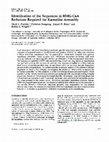Papers by Melissa Parrish

Molecular Biology of the Cell, 1995
In all eukaryotic cells that have been examined, specific membrane arrays are induced in response... more In all eukaryotic cells that have been examined, specific membrane arrays are induced in response to increased levels of the ER membrane protein, HMG-CoA reductase. Analysis of these inducible membranes has the potential to reveal basic insights into general membrane assembly. Yeast express two HMG-CoA reductase isozymes, and each isozyme induces a morphologically distinct proliferation of the endoplasmic reticulum. The isozyme encoded by HMG1 induces karmellae, which are long stacks of membranes that partially enclose the nucleus. In contrast, the isozyme encoded by HMG2 induces short stacks of membrane that may be associated with the nucleus, but are frequently present at the cell periphery. To understand the molecular nature of the different cellular responses to Hmglp and Hmg2p, we mapped the region of Hmglp that is needed for karmellae assembly. For this analysis, a series of exchange alleles was examined in which a portion of the Hmg2p membrane domain was replaced with the corresponding Hmglp sequences. Results of this analysis indicated that the ER lumenal loop between predicted transmembrane domains 6 and 7 was both necessary and sufficient for karmellae assembly, when present in the context of an HMG-CoA reductase membrane domain. Immunoblotting experiments ruled out the simple possibility that differences in the amounts of the various chimeric HMG-CoA reductase proteins was responsible for the altered cellular responses. Our results are consistent with the hypothesis that each yeast isozyme induces or organizes a qualitatively different organization of ER membrane.
Journal of the American College of Cardiology, 2013
The Journal of Pediatrics, 2014
Objective To determine whether patients with coarctation of the aorta (COA) were more likely to d... more Objective To determine whether patients with coarctation of the aorta (COA) were more likely to develop obesity compared with the general population or others with isolated forms of congenital heart disease.
Eukaryotic Cell, 2006
We will remove all metal, felt and flashings from decking on entire house. We will inspect de... more We will remove all metal, felt and flashings from decking on entire house. We will inspect decking, report findings to owner and replace deteriorated planking at $8.00 per linear foot. We will furnish and install an aluminum drip edge flashing along all eaves and rakes. We will install an ice shield membrane in all valleys and around penetrations in roof decking. We will cut riglet into mortar on chimney and replace counter flashing using 26 gauge pre-painted metal. We will furnish and install a 30 lb felt over all decking. We will furnish and install a 1" double lock 26ga. pre-painted standing-seam roofing system complete with all necessary flashings with seam 21" on center. We will replace all pipe collar flashings using roofing material. We will remove all debris associated with work performed.

Biology of Blood and Marrow Transplantation, 2012
The maximum tolerated dose of palifermin, a keratinocyte growth factor, in children is not known,... more The maximum tolerated dose of palifermin, a keratinocyte growth factor, in children is not known, and its pharmacokinetics in this population has not been well studied. This is a phase I study of palifermin was designed to evaluate its tolerability at doses of 40, 60, and 90 μg/kg/day in children age 2-18 years of age, receiving a myeloablative preparative regimen for allogeneic hematopoietic stem cell transplantation (HSCT). In each cohort, palifermin was given for 3 consecutive days before the preparative regimen and for 3 days after the stem cell infusion. Twelve patients were enrolled. Palifermin 90 μg/kg/day was tolerated in 6 patients without dose-limiting toxicity. All patients had at least 1 adverse event, mostly National Cancer Institute grade 1 or 2 severity. Skin rash, grade 2 or lower, was the most common adverse event, seen in 67% of patients. Only 3 patients (25%) had mucositis. The area under the concentration-time curve increased proportionally to the dose, and approximately 97% of palifermin exposure occurred in the first 24 hours after administration. Palifermin clearance increased linearly with body weight, supporting dosing by body weight. The mean clearance was 1893 mL/hour/kg, and it did not change significantly between administration of the first and last doses (P = .80). The mean elimination half-life was 4.6 hours. Our data show that palifermin was tolerated at a dose of 90 μg/kg/day, and exhibits linear pharmacokinetics in children undergoing allogeneic HSCT.
Books by Melissa Parrish
Dear Ms. LeComte,
Attached please find a digital copy of a storyline I appreciate for my locatio... more Dear Ms. LeComte,
Attached please find a digital copy of a storyline I appreciate for my location. The cooking I have not reviewed yet but is standard for a base for vegan, for food for kids', and for food banks. It has religious significance but little authority.
Uploads
Papers by Melissa Parrish
Books by Melissa Parrish
Attached please find a digital copy of a storyline I appreciate for my location. The cooking I have not reviewed yet but is standard for a base for vegan, for food for kids', and for food banks. It has religious significance but little authority.
Attached please find a digital copy of a storyline I appreciate for my location. The cooking I have not reviewed yet but is standard for a base for vegan, for food for kids', and for food banks. It has religious significance but little authority.